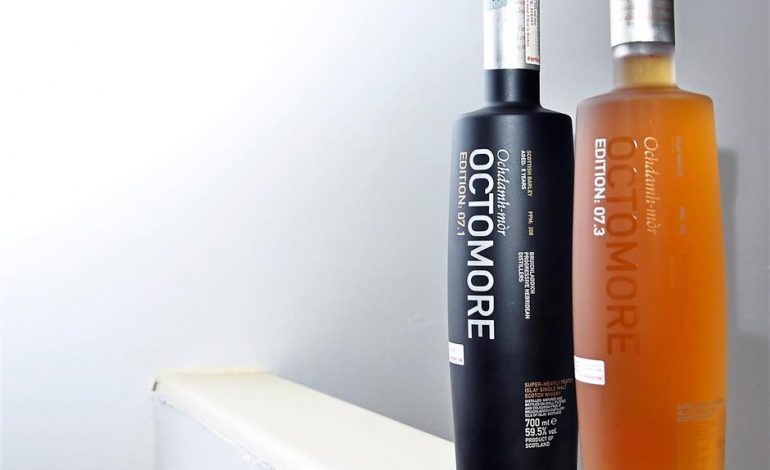An Islay whisky, from start to finish
Sign up now: Weekly recommendations for the best eats in town

Bruichladdich’s Octomore expressions are among the world’s most heavily peated whiskies.
PHOTO: THE STAR / ANN
Follow topic:
KUALA LUMPUR (THE STAR / ANN) - The Scottish island of Islay is well-known for its smoky, peaty whiskies, as peat is found in abundance on the island off the southwest coast of Scotland. However, funnily enough, another vital ingredient in the production of Scotch, barley, was actually not commonly grown on the island until around 2002-2003, when the Bruichladdich distillery decided to come up with their Islay Barley Exploration range.
Founded in 1881 by brothers William, John and Robert Harvey, the distillery had been closed for six years when a group of private investors bought the distillery in 2000 and refurbished it, hiring former Bowmore distiller Jim McEwan as its master distiller.
Since then, Bruichladdich has carved a reputation for an independent and artisanal view towards its whiskies, priding itself on producing whiskies that use 100 per cent Scottish barley.
Then in 2002, McEwan decided to go further with that philosophy and come up with a whisky that uses only barley farmed on Islay.
There was only one problem though - there were no farmers planting barley on Islay at the time!
According to Bruichladdich brand ambassador Murray Campbell, McEwan then started approaching farmers to see if they would agree to grow barley for the distillery.
"The idea was that they would grow the barley, and we would take it to make whisky. We were very, very excited about the idea, but unfortunately, the farmers were not so excited at the beginning!" he explained.
"They had been rearing sheep and cattle their whole lives, and didn't know how to grow barley. As farmers, they needed a degree of safety and routine, so they can plan for the future. But with barley, they are no longer in control - the weather is. If you have an amazing summer of weather but heavy rain in the last couple of weeks, then your crop's wrecked."
According to him, in the beginning, only one farmer was growing barley for them. The result was Bruichladdich's first 100 per cent Islay bottling, the Bruichladdich Islay Barley 2004.
"That first edition from this single farm showed the others that growing barley on Islay was not impossible," said Campbell. "After that, more farms came on board, and now we've got 19 farms growing barley for us. We look after these farmers by signing long-term contracts with them."
Since then, there have been three more batches in the Islay Barley Exploration series - the 2006, 2007, and 2009, which was recently launched in Malaysia.
"The year you see on the label represents the distillation year of the whisky, which is the year it went into the cask. That means that the barley we use for the current bottling was planted in April 2008, and harvested August 2008, and distilled in early 2009," he said, adding that Bruichladdich is one of only two Islay distilleries that have 100 per cent Islay barley expressions.
At 50 per cent alcohol by volume (ABV), the Islay Barley 2009 is undoubtedly strong. Although it is unpeated, there is some subtle peat on the nose, but on the palate, it has a candied fruits and citrus sweetness that carries through to its sweet, malty finish.
The distillery currently releases three expressions that use 100 per cent Islay barley, including 100 per cent Islay versions of the core range Bruichladdich Classic Laddie and Port Charlotte, as well as the Octomore. However, the Port Charlotte Islay Barley is currently not available in Malaysia.
While the Islay Barley series uses only barley from the island, the other expressions still maintain the distillery's 100 per cent Scottish philosophy by using only barley grown in Scotland.
According to Campbell, the Islay Barley 2009 is the first expression that uses barley grown in four different Islay farms.
"The reason we could not do a single farm this time around is because each of these farms were unable to give us the quantity that we require for single farm status. So we had to combine all four together to get a proper release," he said.
"The only farm we do allow to give us less than that set amount is Octomore farm. Whatever they can produce, we'll take it, and still make Octomore. We have a very good relationship with the farm - we get the source of our spring water from Octomore Farm, and we also have a product called Octomore," said Campbell.
Created by McEwan to prove that a whisky can be heavily peated and still taste good, the "Octomore of Octomore" series is under a range that includes some of the most heavily peated whiskies in the world, and is distilled only from barley grown on the Islay farm and soaked in its unique maritime climate.
The Bruichladdich Octomore 7.3 is the latest release in the series; it was distilled in 2010 from grain harvested in 2009 and matured in American Bourbon barrels and Spanish wine casks of Ribera Del Duero.
Despite the heavy peat in the whisky, the Octomore 7.3 is surprisingly delicate on the nose and the palate. Yes, the peat does stand out at first, but it gives way to a a sweet and salty palate, with hints of peaches and apricots on a background of subtle smoke, and a long, lingering finish.
Still, does using only Islay barley really make that big a difference in the whisky?
Comparing the Islay Barley 2009 with the core Classic Laddie, which uses Scottish mainland barley, there was a distinct difference between the two - there was a bit more complexity in the Islay Barley, and a subtle saltiness caused no doubt by the island's maritime influences.
It is enough to make you wonder just how different the other Islay whiskies would taste if they all used Islay barley as well.

